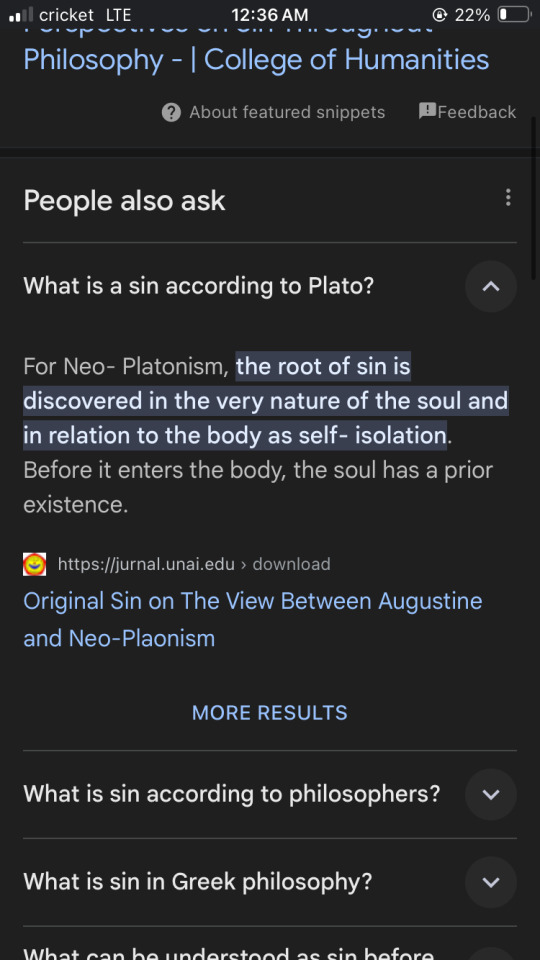#maa kheru
Text
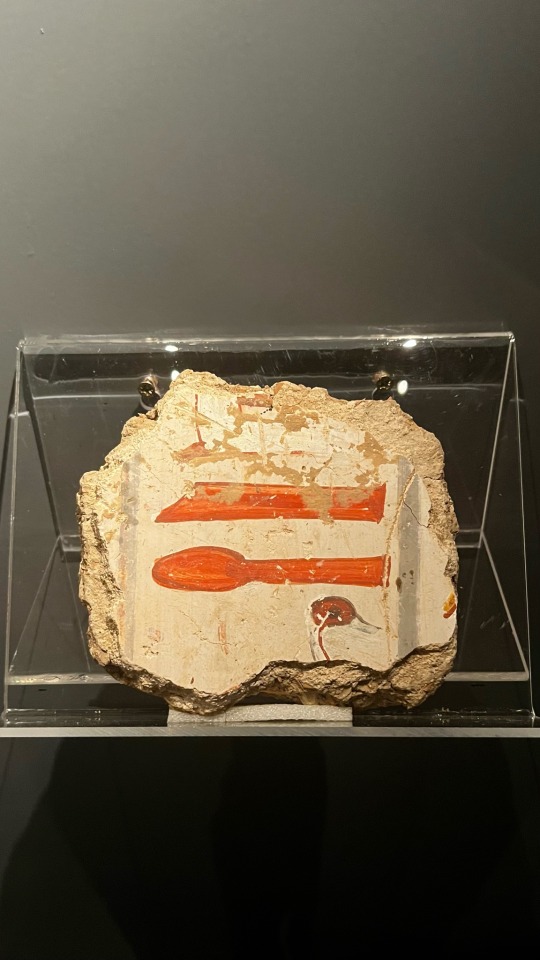
Maa Kheru is a phrase meaning "true of voice" or "justified" or "the acclaim given to him is 'right'". The term is involved in ancient Egyptian afterlife beliefs, according to which deceased souls had to be judged morally righteous. The phrase was often used to denote someone who had died and become a god, placed after the name of the individual in question.
Museum of Fine Arts, Budapest
#egypt#ancient egypt#egyptian#egyptology#hieroglyphs#ancient#dark academia#dark academia style#dark academia blog#academia#budapest#museum#antiques#museum of fine arts#dark academia aesthetic#art academia#academic#light academia#green academia#academia aesthetic#classic academia
11 notes
·
View notes
Text
0 notes
Text
Examples of this [funerary texts being applicable to living as well as dead people] is also to be found in the realm of Kingship rituals where some rituals changed status in time, so that rituals intended for the coronation of the king was transferred in Ptolemaic times to holy animals and their induction into the temple.
Quack has put forward the suggestion that at least some parts of the ritual for opening of the mouth edited by Otto was originally intended for the living king. Shirun-Grumach has also suggested a place for the ritual at the accession of a new king.
According to her, the purpose of the ceremony was to render the king ma’a-kheru, which she interprets as one who has the capacity for effective ritual language. In this way the ritual of opening the mouth could be a decisive moment in the transition from descriptive to creative use of language.
In connection with the discussion of the role of Sia in ritual language, it is important that this god effects the opening of the mouth in spell 816 of the Coffin texts, which relates the opening of the mouth to knowledge and passage into the beyond.
The spell takes as it starting point an invocation to the iron (biA), which serves as a tool in the ritual. The mouth of the speaker is touched with the iron opening his mouth, an action that is simultaneously seen as the speaker’s ascent and opening of the west. The opening of the mouth is then connected to the capacity for speaking Maat and furthermore to Sia: ‘I have seen Sia opening my mouth that he may relate a true thing to the lord of all (nb tm).’
The ability to speak Maat recalls both the status of Maa-Kheru and Hu, the effective utterance that Sia allows.
- Secrets, Knowledge and Experience in AE Religion, Jens Jorgensen, pg 79
#quotes#kemetic book quotes#heka#maa kheru#true of voice#ma'at#sia#hu#ootm#opening of the mouth#rites#rituals#ct#everything you know is a lie#iron#kemetic#jorgensen
22 notes
·
View notes
Text
TR4 - Valley of the kings (1)
Lara look at the amulet of Horus and thought: I am in trouble. After killing some men she is ready for some adventure in the valley of the kings.
05.01 - Hieroglyphics
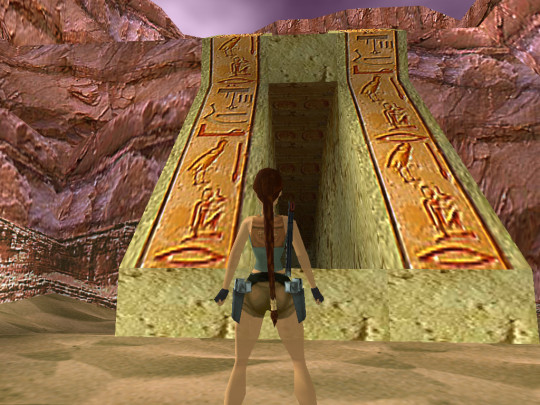
These hieroglyphics came from the El-Kharga oase in Egypt, according to some site. In the hieroglyphics I read the word Maa Kheru which means “voice of truth” the title of the diseased.

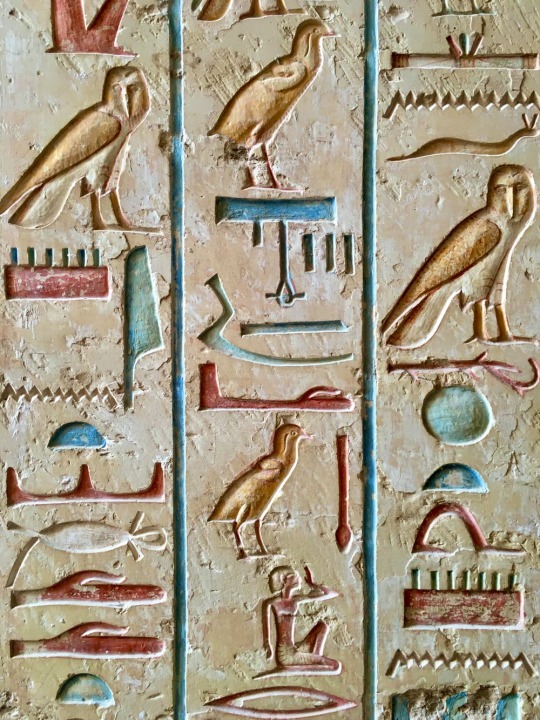
From here: https://images.pexels.com/photos/3199399/pexels-photo-3199399.jpeg
05.02 - Cartouche
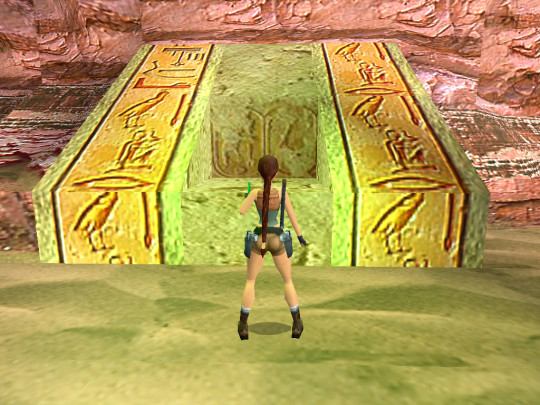
I think it is the cartouch of Rameses II.

05.03 - VIew

The view looks very similar to the mountains of the Thebes. There is a hill called El-Qurna that looks a bit like a pyramid.

#valley of the kings#tomb raider 4#tr4#Tomb Raider IV#Lara Croft#Hieroglyphics#Maa Kheru#Cartouche of Rameses II#El-Qurna
23 notes
·
View notes
Text
THE SOURCE OF SUFISM
THE SOURCE OF SUFISM by Moustafa Gadalla, published in Egyptian Mystics (2003)
“The common premise is that “Sufism” is an Islamic group practicing a form of mysticism that originated in Persia.
As the book progresses, we will find that “Sufism” has nothing to do with Islam or Persia, and everything to do with the quiet peoples of Ancient and Baladi Egypt. Two points of interest should be mentioned here:
The term and practices of “Sufism” surfaced as a result of Islamic conquests and the subsequent terrorizing of its victims. In order for the Islamic-terrorized masses to maintain their ancient traditions, they had to camouflage old traditions under an Islamic garment.
The pure form of “Sufism” originated in Egypt. Other countries copied it and were quick to take the credit for it. Their application of “Sufism” is impure and incomplete, as we will find throughout this book.
The common premise (mentioned above) about the roots and essence of “Sufism” is absolutely wrong, as we will conclude by examining the facts throughout this book. Here are just a few introductory facts:
1. The notion of an Islamic origin of “Sufism” is wrong. “Islamic mysticism” is an oxymoron—as per the following selected points:
The mystical seekers who are called “Sufis” have always suffered from Islamic rule throughout the ages. Many have been killed. They have been accused of attempting to make innovations on the dogmas of Islam; of following practices forbidden by the Koran; of denying the very existence of a personal Allah. The tolerance, or lack thereof, of Sufism in the Arabized/Islamized world is closely linked to the whim of the ruler and how he interprets/enforces Islamic laws. During certain periods, Sufism was/is tolerated; during others, it was outlawed and condemned.
The keynote of mysticism (Sufism) is the union between man and God which, in Islam, is considered blasphemy; and as such is punishable by death by any Moslem, who is “empowered” to do so by the Koran itself!
Islamic teachings are characterized by a consuming fear of God’s wrath, while the Egyptian model of mysticism (Sufism) emphasizes love and not fear. God is perceived in terms of emotional closeness—“the friend,” “the lover”—whose love can be experienced personally and individually.
Mysticism (Sufism) is based on self-attained revelations by mystical means, which is contrary to Islam. Such revelations, as experienced by the mystical seekers (Sufis), are considered blasphemy and therefore are punishable by death, as established in the Koran.
The Egyptian mystical seekers (Sufis) include in their ritual practices (as well as public festivals) specific methods to achieve ecstatic proximity to God through music, dance, or song. This runs contrary to Islam, where music, singing, and dancing are strictly forbidden, as clearly stated in all treatises on Islamic laws.
Contrary to Islamic doctrine, Egyptian mysticism (Sufism) bridges the gulf between man and God with folk saints. Veneration of folk saints and pilgrimages to their shrines represent an important aspect of the Egyptian Baladi mystical practices which is totally against the Islamic doctrine.
2. The claim of a Persian origin of “Sufism” is also wrong. The Persians themselves refer to Egypt as the source of “Sufism”. For example:
a. The Egyptian Dhu ‘l-Nun (died in 860 CE) is recognized in all Islamized Sufi references as the spiritual source of “Sufism” who prepared the way for the presently-known form of Islamized Sufism. Sufis claim him for their own as a leader and the originator of important concepts such as the mystic’s direct knowledge (gnosis) of God and the stations and states of the spiritual Path. Dhu ‘l-Nun was knowledgeable of the Ancient Egyptian hieroglyphs. A number of short treatises which deal with alchemy, magic, and medicine are attributed to him.
b. Thoth (Tehuti), the Ancient Egyptian neter (god), is recognized by all early (and later) Sufi writers as the ancient model of alchemy, mysticism, and all related subjects.
The well- known Sufi writer Idries Shah, who was an Iranian/Persian himself, admits the role of Egypt via Thoth and Dhu’I-Nun on Sufism and alchemy as follows:
. . . alchemical lore came from Egypt direct from the writings of Thoth . . . According to Sufi tradition the lore was transmitted through Dhu’i-Nun the Egyptian, the King or Lord of the Fish, one of the most famous of classical Sufi teachers. [The Sufis, 1964]
Thoth’s name appears among the ancient masters of what is now called the Way of the Sufis. In other words, both the Sufis and the alchemists recognize Tehuti as the foundation of their knowledge.
Idries Shah also makes a direct reference to the Spanish-Arab historian Said of Toledo (who died in 1069) who outlines this tradition of the Ancient Egyptian Thoth (aka Hermes):
Sages affirm that all antediluvian sciences originate with the Egyptian Hermes [Thoth], in Upper Egypt. The Jews call him Enoch and the Moslems Idris. He was the first who spoke of the material of the superior world and of planetary movements . . . Medicine and poetry were his functions . . . [as well as] the sciences, including alchemy and magic. [Cf. Asin Palacios, Ibn Masarra, p. 13]
c. It is an indisputable fact that all Sufi mystical terms are not Persian (or Turkish). All Sufi terms are “Arabic”. The “Arabic” language is substantially of Egyptian origin. After the Arab/Islamic conquests of their neighboring countries (including Egypt), they simply cancelled the identity of their victimized countries,= and labeled them “Arabs”.
3. To continue the point above (regarding the language of Sufism), it should be noted that the word Sufi was never mentioned in the Koran or in Mohammed’s sayings. There is no consensus on its meaning. The “translation” of the word/term “Sufi” as a “wearer of wool” is totally fabricated, and is one of many attempted explanations.
The word is actually of Ancient Egyptian origin. Seph/Soph was a component of common Egyptian names; meaning wisdom and purity (among many other meanings).
4. Some of the standard Sufi terms that are often used are: old religion, antique faith, old one, andancient tradition. Such terms were used/stressed by all early Sufi writers, which is indicative of the pre-Islamic origins of Sufism.
5. The Egyptians are remarkable traditionalists to a fault. Early historians have attested to this fact, such as: Herodotus, in The Histories, Book Two, 79:
The Egyptians keep to their native customs and never adopt any from abroad.
And Herodotus in The Histories, Book Two, 91:
The Egyptians are unwilling to adopt Greek customs, or, to speak generally, those of any other country.
Plato and other writers affirmed the complete adherence of the Egyptians to their own traditions.
6. Supernatural powers acclaimed by the mystics (Sufis) are often called magic. From the earliest times, Egypt has been celebrated for its magicians, and accounts of their marvelous achievements have been documented not only in Ancient Egyptian records, but also in the Bible and in the works of several classical writers. Furthermore, many of the tales in the famous collection of stories known as The Arabian Nights show what wonder-working powers were attributed to magicians in medieval Egypt.
Heka [shown above] represents the Ancient Egyptian magical power of words. He is usually depicted holding two snakes with total ease.
7. The country that has the largest number of “Sufi” followers is Egypt. Participation in Sufi fellowships (orders) in other countries besides Egypt is very small in comparison.
Egyptian mysticism (Sufism) is not an offshoot of Islam; it is the old “religion” camouflaged into Arabized/Islamized terms.
Egyptian mystical seekers (Sufis) maintain low profiles, for they seek no public glory; but rather the ultimate mystical glory—The Divine.”
Previous: Preface [1st Edition]
Next: Chapter 6 : The Way to Revelations
#Sufi#sufism#egyptian mysticism#Religion#spirituality#spiritual#truth#Ancient Egypt#egyptology#early christianity#Cordoba#moors#moor#history#Alchemy#moustafa gadalla#maa kheru#tehuti#thoth#egyptian#ancient#ancient wisdom#theology
62 notes
·
View notes
Text
The Negative Confession (also known as The Declaration of Innocence or the 42 principles of Maat)
1. Hail, Usekh-nemmt, who comest forth from Anu, I have not committed sin.
2. Hail, Hept-khet, who comest forth from Kher-aha, I have not committed robbery with violence.
3. Hail, Fenti, who comest forth from Khemenu, I have not stolen.
4. Hail, Am-khaibit, who comest forth from Qernet, I have not slain men and women.
5. Hail, Neha-her, who comest forth from Rasta, I have not stolen grain.
6. Hail, Ruruti, who comest forth from Heaven, I have not purloined offerings.
7. Hail, Arfi-em-khet, who comest forth from Suat, I have not stolen the property of God.
8. Hail, Neba, who comest and goest, I have not uttered lies.
9. Hail, Set-qesu, who comest forth from Hensu, I have not carried away food.
10. Hail, Utu-nesert, who comest forth from Het-ka-Ptah, I have not uttered curses.
11. Hail, Qerrti, who comest forth from Amentet, I have not committed adultery.
12. Hail, Hraf-haf, who comest forth from thy cavern, I have made none to weep.

13. Hail, Basti, who comest forth from Bast, I have not eaten the heart.
14. Hail, Ta-retiu, who comest forth from the night, I have not attacked any man.
15. Hail, Unem-snef, who comest forth from the execution chamber, I am not a man of deceit.
16. Hail, Unem-besek, who comest forth from Mabit, I have not stolen cultivated land.
17. Hail, Neb-Maat, who comest forth from Maati, I have not been an eavesdropper.
18. Hail, Tenemiu, who comest forth from Bast, I have not slandered anyone.
19. Hail, Sertiu, who comest forth from Anu, I have not been angry without just cause.
20. Hail, Tutu, who comest forth from Ati, I have not debauched the wife of any man.
21. Hail, Uamenti, who comest forth from the Khebt chamber, I have not debauched the wives of other men.
22. Hail, Maa-antuf, who comest forth from Per-Menu, I have not polluted myself.
23. Hail, Her-uru, who comest forth from Nehatu, I have terrorized none.
24. Hail, Khemiu, who comest forth from Kaui, I have not transgressed the law.
25. Hail, Shet-kheru, who comest forth from Urit, I have not been angry.
26. Hail, Nekhenu, who comest forth from Heqat, I have not shut my ears to the words of truth.
27. Hail, Kenemti, who comest forth from Kenmet, I have not blasphemed.
28. Hail, An-hetep-f, who comest forth from Sau, I am not a man of violence.
29. Hail, Sera-kheru, who comest forth from Unaset, I have not been a stirrer up of strife.
30. Hail, Neb-heru, who comest forth from Netchfet, I have not acted with undue haste.
31. Hail, Sekhriu, who comest forth from Uten, I have not pried into other's matters.
32. Hail, Neb-abui, who comest forth from Sauti, I have not multiplied my words in speaking.
33. Hail, Nefer-Tem, who comest forth from Het-ka-Ptah, I have wronged none, I have done no evil.
34. Hail, Tem-Sepu, who comest forth from Tetu, I have not worked witchcraft against the king.
35. Hail, Ari-em-ab-f, who comest forth from Tebu, I have never stopped the flow of water of a neighbor.
36. Hail, Ahi, who comest forth from Nu, I have never raised my voice.
37. Hail, Uatch-rekhit, who comest forth from Sau, I have not cursed God.
38. Hail, Neheb-ka, who comest forth from thy cavern, I have not acted with arrogance.
39. Hail, Neheb-nefert, who comest forth from thy cavern, I have not stolen the bread of the gods.
40. Hail, Tcheser-tep, who comest forth from the shrine, I have not carried away the khenfu cakes from the spirits of the dead.
41. Hail, An-af, who comest forth from Maati, I have not snatched away the bread of the child, nor treated with contempt the god of my city.
42. Hail, Hetch-abhu, who comest forth from Ta-she, I have not slain the cattle belonging to the god
150 notes
·
View notes
Note
Sorry if I'm being ignorant, but what exactly was wrong with the whole "reconstructing the mummy's voice" thing? I've seen you reference it a couple of times as a misstep, but I haven't heard many others saying that, so I'd deeply appreciate your explanation.
It was an ethic clusterfuck of epic proportions, and basically all of Egyptology went “What??? the fuck??????”.
The main point is, of course, that a mummy can’t consent to any type of research done on their bodies. That’s why we have ethics in place, and almost every Egyptologist I know has either been taught ethics over the course of their degree, or, if they got their degree prior to ethics become more and more of a concern (as it should), worked to teach themselves. The scientists involved with this research are, barring one, not Egyptologists, and basically they treated Nesyamun as having never been anything more than an inanimate study object. They did try to give an ethical justification, but this “justification” was based on a poor and partial reading of Egyptian funerary beliefs. It was, quite frankly, more of an insult than it was a justification.
They used one of Nesyamun’s epithets, as written on his coffin, namely mAa-xrw, ‘justified’, or more literally: ‘true of voice’. This was claimed to denote Nesyamun’s wish to “speak and be heard after death by the living”. From their paper (emphasis mine):
This was a vital clarification within ancient Egyptian culture in which the name was regarded as essential to an individual as their physical (mummified) body and their soul (ka) and spirit (ba). It was also a fundamental belief that ‘to speak the name of the dead is to make them live again’ (alternatively translated: ‘a man is revived when his name is pronounced’), both by living relatives and by the deceased themselves when appearing before the gods of judgement. Only those able to verbally confirm that they had led a virtuous life were granted entry into eternity and awarded the epithet ‘maat kheru’, ‘true of voice’, as applied to Nesyamun himself throughout his coffin inscriptions. In these texts, Nesyamun asks that his soul receives eternal sustenance, is able to move around freely and to see and address the gods as he had in his working life. Therefore his documented wish to be able to speak after his death, combined with the excellent state of his mummified body, made Nesyamun the ideal subject for the ‘Voices from the Past’ project for which his body was re-examined using state-of the-art CT scanning equipment.
Two problems already:
mAa-xrw is an epithet given to literally every deceased person. A deceased becomes mAa-xrw by virtue of having passed through the afterlife trials; it was nothing specific to Nesyamun.
mAa-xrw, and by extension the desire to be able to speak one’s own name in death, does not mean they want their mummy to physically speak in the realm of the living. mAa-xrw is a state of being, not a wish to enact.
So their justification was, if not an outright deliberate twisting of Egyptian funerary beliefs, at the very least a complete misunderstanding of these beliefs. If you read the rest of the paper, it becomes clear they’re mostly doing it for the interest it’d garner among a lay public. They talk about how it can “excite” people to hear “a mummy’s voice”, etc. But the research as it is did literally nothing to further the field of Egyptology, when that’s the only valid reason to even begin thinking about doing research on a mummy.
This is all bad enough, but it doesn’t stop there!
Another concern is the fact that after three millennia, even though Nesyamun was preserved so well, his voice box still was not complete. They would have to reconstruct the fleshy flappy parts from scratch anyway if they wanted a fully functional box. So this whole thing was all moot because it would never be able to approximate Nesyamun’s voice in life. Even if it has been able to, what would be the use? It’s not like we can ask the reconstructed voice box how to pronounce Late Egyptian. All we can do is make it say the things we want it to say.
This is usually the point where non-experts will - usually in good faith - point out that this type of research can be valuable for living people with incomplete/non-functional voice apparatuses. To them I have only one thing to say: it would NOT be hard to find living subjects who can actually consent to being scanned and have 3D-printed reconstructions done based on their voice box.
And lastly, the thing that’s just actually gross: they used their own voices - white researchers! - to make Nesyamun’s voice box emit a sound not unlike a dying goat. A human being, reduced to memes and laughter on the internet, because of these researchers’ vanity project.
And then they had the gall to say that “the benefits outweight the concerns”:
Since human remains have unique status not as ‘objects’ but as the remains of once-living people (see SI), it was also necessary to consider the ethical issues raised by the research and its possible heritage outcomes. The team concluded that the potential benefits outweighed the concerns, particularly because Nesyamun’s own words express his desire to ‘speak again’ and that the scientific techniques used were non-destructive.
No, they the fuck do not. You can’t just say “well, you know, since the science we used was non-destructive, everything’s A-OK!” when you’re blatantly fucking around with a human’s body for the coolness factor and using a screwed up reading of Egyptian funerary beliefs to “justify” it.
#egyptology#nesyamun#ethics#lordgibbon#I can't abide the hypocrisy#just say you don't think of mummies as human and go#PS. any anger in this ask is wholly directed at the team and not at you haha#don't worry about something being perceived as ignorance if you literally just want to find out what it is I'm talking about xx
357 notes
·
View notes
Photo

vampires are immortal, nocturnal beings that require a steady diet of human blood in order to sustain themselves. all vampires share some common traits with one another, such as their vulnerability to sunlight, fangs, and their ability to enter a state of hibernation known as ‘somnus’ when starving or gravely injured. however, each vampire belongs to one of six bloodlines which dictates the unique abilities that they inherit.
ALUKAH
the oldest bloodline, (and, as some might consider them, the most primative), able to manifest sharp talons, a mouthful of fangs, and instil a sense of fear in those around them. however, they are also the bloodline to struggle most with their self-control and the longer they go without feeding, the more monsterous their appearance becomes.
LAZARITES
one of the ‘young’ bloodlines, lazarites are able to feed on the blood of the dead and gain just as much sustainence as they would from the living. additionally they are unable to feel pain, no matter how devestating their injuries. lazarites tend to be more solitary than other bloodlines, and no matter how well-fed they are, they appear pale and sickly, making it difficult to blend in among mortals.
MAA KHERU
the maa kheru have the ability to detect deception in the voices of others and can, if necessary, project their will for a short distance beyond their physical bodies while sleeping away the daylight in order to relay an urgent message or protect themselves. however, their reverence for custom and tradition has led to their inability to enter a private resedence without invitation.
NISKAI
another young bloodline, the niskai are more vulnerable to sunlight than other bloodlines, with even a minute or two of direct sunlight proving deadly. instead they draw strength from the darkness, enabling them to manipulate shadows, extinguishing lights in their vicinity or travelling from one patch of shadow to another without occupying the space between.
UBARA
the ubara are what one tends to think of when it comes to the modern pop culture ‘vampire’. they are almost without exception beautiful (though whether that’s thanks to selective turning or a trait of their bloodline is up for debate) and possess the ability to compel other non-vampires. their unique weakness is a vulnerability to objects associated with faith - religious or otherwise.
VARA
the noble vara are the most numerous bloodline after the ubara and niskai, and possess the ability to control and see through the eyes of animals. each vara has an affinity for a particular kind of animal, usually dictated by what naturally occurs in their resident territory. this connection to nature also gives them their weakness in that a prospective vara fledgeling must be buried in the earth in order for them to rise again, and thereafter must sleep with or near a handful of that same dirt in which they were buried.
3 notes
·
View notes
Text
Additional AUs and Verses
musician | desecrate through reverence
Instead of crime and children’s card games, Malik is the front man and co-founder of the band, Kheru (derived from the term Maa Kheru meaning "true of voice" or "justified” aka a soul that was judged morally righteous in the Afterlife), that toys between dark/pagan folk and rock genres who’s lyrical content is often derived from Ancient Egyptian cultural and esoteric traditions as well as poetry and often makes use of traditional instruments such as the long flute, lyre, and double clarinet as well as more modern instruments. Eventually they were found on YouTube and the band quickly began to grow in popularity.
The band has often been compared to Wardruna and The Hu.
assassin / spy | slipping into the shadows
The gig with INTERPOL went a little too well and he was eventually tapped by the intelligence community. He gained the training to engage in espionage as well as carefully and discretely taking out select targets. Eventually he had gone rogue, hating being on anyone’s leash.
teenage arc | let the whole world collapse
Covers the events from the time he had founded the Ghouls until the Ceremonial Duel, DSOD, and his early start with INTERPOL. (ages 13-18)
relapse | underground but we will not surrender
Malik who had been on the path of redemption had relapsed into old habits. The syndicate is rebuilding and he re-enters the criminal world a little wiser. He continues to place an emphasis on antiquities and forgeries, however he has been known to start dabbling into the arms and drug trafficking trades.
death note | can't take a holy war
Malik has officially joined INTERPOL as an liaison and works with his former handler in part of the effort of a hunt for Kira.
#;; verses#;; desecrate through reverence (musician)#;; slipping into the shadows (assassin)#;; let the whole world collapse (teen arc)#;; underground but we will not surrender (relapse)#;; can't take a holy water (death note)
4 notes
·
View notes
Photo

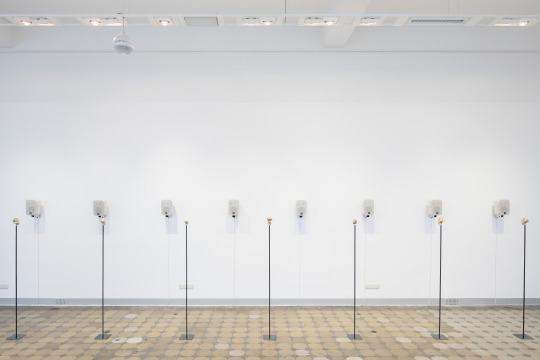





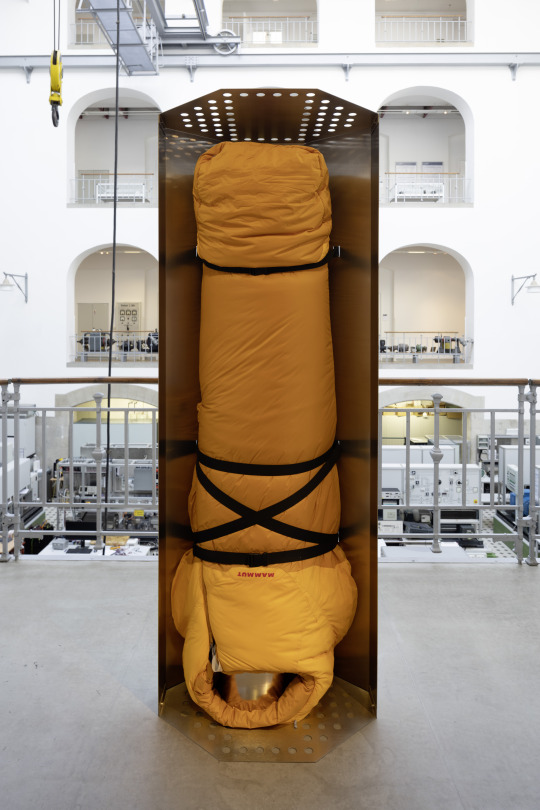

A&I
University Gallery of the Custody, Dresden, 2021
Maa Kheru
8-channel sound installation (dimensions variable), 7 min (looped)
Golden Tongues
24-carat gold, polyamid, metall
If you love life like I do
Stainless steel, aluminum, sleeping bag, belt
210 x 76 x 64 cm
Mrs. Conant
HD-Video, 120 sec (loop)
Drawing on earlier works of his, Christian Kosmas Mayer explored cultural-historical concepts of immortality against the backdrop of the present day and the radical advances currently sweeping across the fields of biotechnology and artificial intelligence (AI).
In his research practice, the human voice plays a pivotal role as a primordial medium of expression, of vital importance in ideas relating to the afterlife, be it in ancient Egypt or the present day. Because we live in an age when AI enables us to synthesize the voices of those long-dead and thus revive them in digital form, their voices are able to float free of their bodies, living on through technology in an afterlife that is potentially never-ending. By partnering with the Chair of Speech Technology and Cognitive Systems at the TU’s Institute of Acoustics and Speech Communication, Mayer has now used the latest speech-synthesis technology to produce sounds based on the vocal tract of a specific human being who lived 2000 years ago. From these sounds, he has composed a moving and enigmatic multi-channel sound piece that combines the archaic with the hypermodern and upends our conventional notions of age and the passing of time. (more information on this work can be found in this interview: https://between-science-and-art.com/artist-in-residence-christian-kosmas-mayer/)
The disembodied and lingering presence of the voice finds its materialized and ossified echo in the sculpture series the Golden Tongues. Models of human tongues from the late 19th century preserved in the Historical Acoustic-Phonetic Collection at the TU Dresden were the source for replicas that were transformed into extremely durable metal objects. The technique of gilding has been used since antiquity to lend objects a timeless finish, giving them the chance to escape the finite time scale of each passing human civilization.
Mayer is especially drawn to such phenomena and objects, which, even in death, know no rest and drift through time, resurfacing at various points in history in different contexts and charged with different meaning. This is also evident in his AI-generated animations of vintage photographs dating from the mid-19th century, when photography itself was still considered a magical medium by many. The late sci-fi author and physicist Arthur C. Clarke (1917–2008) once claimed that “any sufficiently advanced technology is indistinguishable from magic”. If that be true, then the latest advances in biotechnology and AI will one day have previously unimagined ways to seduce us into interpreting the ghostly phenomena of autonomous algorithmic computations as works of magic.
As a commentary on the current discourse surrounding AI applications in biotechnology, Christian Kosmas Mayer’s poetic, sensual, and at-once imaginatively speculative approach presents a glimpse of this future. And rather than examining it as separate to Humanism and traditional knowledge systems, Mayer shows how such a future is actually rooted in and predetermined by them.
These works were supported by Schaufler Lab@TU Dresden
-------------------------
Text on the single works:
Maa Kheru
Egyptian mummies are physical relics of a highly advanced ancient civilization for which the search for immortality was a defining cultural impetus. In his performative approach to a 2000-year-old male mummy, Christian Kosmas Mayer draws on the ancient Egyptian belief that the dead can only attain eternal life if their voices are revived. Using data obtained from computed tomography (CT) scans, researchers were able to create an exact replica of the mummy’s vocal tract, even endowing it with a movable silicon tongue. Mayer played this artificial vocal organ as though it were an instrument and produced a range of vocal sounds from which he then composed a multi-channel sound piece. Falling somewhere between scientific precision and poetically speculative experiment, the resulting sounds take us into the depths of time and combine the archaic with the hypermodern.
Golden Tongues
The TU’s Historical Acoustic-Phonetic Collection contains a ceramic model from 1895, made to illustrate the formation of vocal sounds in human speech and song. Made of changeable parts, this anatomical model served as a teaching aid in vocal training for professional singers, which is why some of its parts include distinct shapes of the human tongue, each representing a different sound. For his sculpture series, Christian Kosmas Mayer appropriates the forms of these historical models and renders them in a material that transcends their original functionality. By gilding his replicas, Mayer makes use of an ancient cultural practice that has always been associated with the pursuit of timelessness. Any use of “immortal gold,” as alchemists called it, is not just an aesthetic decision – it is also a reflection of an attempt to transcend the lifespan of human civilization.
If you love life like I do
Cryonics is the term for the preservation of human bodies at very low subzero temperatures, in the hope of being able to bring the deceased back to life at some unknown point in the future. In speculative anticipation of possible breakthroughs in medical science and technology, the bodies are cooled in liquid nitrogen to -196 degrees Celsius and stored in metal containers. Several hundred bodies are currently being kept in what is hoped to be a suspended rather than final state – and that number is on the rise. After conducting research into a US cryonics company, Christian Kosmas Mayer made these sculptures to point to the little-known existence of these modern-day mummies and visualize this as yet indefinable duration of icy quiescence. Upside down in sleeping bags, they await their own personal resurrection through science.
Mrs. Conant
Deepfakes use artificial intelligence to generate fake videos whose simulated content seems convincingly real. As such, deepfakes are part of a long tradition of manipulative visual techniques going back centuries. The American photographer William H. Mumler (1832−1884) was a pioneer of photographic manipulation, using double exposure to create spirit photographs in which he claimed to capture the spectral image of the dead. Christian Kosmas Mayer takes these historical fabrications and combines them with the latest technology to create AI-generated animations of the people in Mumler’s photographs. Guiding the mimical transformation of the originally still portraits are Mayer’s own facial expressions. The artist recorded the movements of his face on video and then fed the training data to a facial expression algorithm. In the final work, we see the artist literally putting words in the mouths of people photographed more than 150 years ago, but whatever they are saying remains inaudible to us.
#schauflerlab@tudresden#immortality#ai#cryonics#antonginzburg#williammumler#mummy#voice#tongue#reanimation
1 note
·
View note
Text
AFUNATION
#AFUNATION
Artist Name: AFUNATION
Artist Bio
DEVON A BLAIR JR, AKA 'AFU MAA KHERU' WHICH MEANS ''JUSTIFIED OR THE ACCLAIMED GIVEN HIS RIGHT'' IS THE PRODUCER/ARIST AND LATORSHIA K SPENCER IS AN ARTIST. TOGETHER THEY ARE AFUNATION RECORDS. WE HAVE OUR HANDS ON EVERY FACET OF BUILDING A BURGEONING IMPRINT.
Tell us who you are:
WE ARE AFUNATION RECORDS. FOUNDED AND OWNED BY DEVON A BLAIR JR AND…

View On WordPress
0 notes
Text
Flying Disk...Otherworldly...Ancient Egypt...
Flying Disk…Otherworldly…Ancient Egypt…
And Isis sent forth her voice into heaven, and made supplication to the Boat of Millions of Years, and the Disk stopped in its journeying, and moved not from the place whereon it rested. Then came forth Thoth, who is equipped with his spells (or, words of power), and possesseth the great word of command of maa-kheru, and said: “What aileth thee, O Isis, thou goddess who hast magical spells, whose…
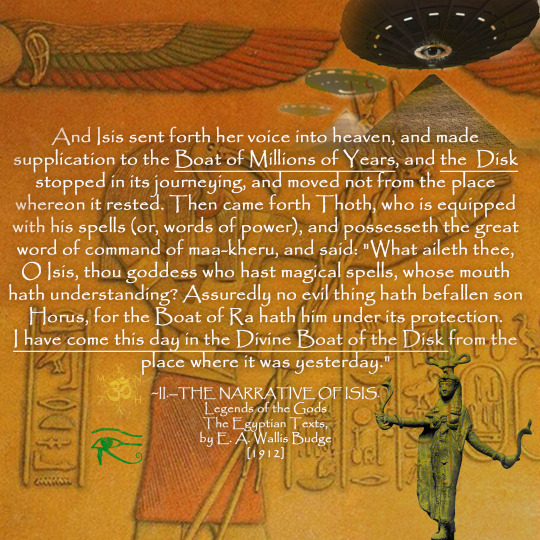
View On WordPress
#Ancient Civilizations#Ancient Egypt#Astral Beings#Books#Flying Disk#ISIS#Light Beings#Magic (Quotes)#Otherworldly (Quotes)#Otherworldly Life#Thoth#uap#ufo#UFO&039;s In Religious and Early Century Art
0 notes
Photo

Maa Kheru
❝TRUE OF VOICE
⸨ AU Atem Aesthetics Blog. Highly selective. Discord on request only. ⸩
3 notes
·
View notes
